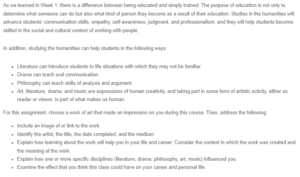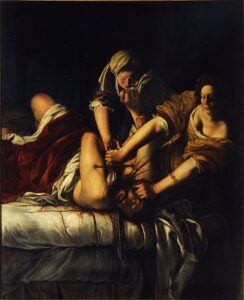Interdisciplinary Works Reflection – Judith Slaying Holofernes by Artemisia Gantileschi
Option 3: Choose a work of art from any genre that depicts or tells the story of a real life event from any time period.
Painting: Judith Slaying Holofernes
Artist: Artemisia Gantileschi
Year: 1620-21
There are no notes by the painter; neither are there any known comments made by the painter.
This piece of art depicts the beheading of Holofernes by Judith, a story that is found in the Dead Sea Scrolls book of Jubilees. It is one of the artist’s iconic works, with early feminists interpreting the piece of art as a form of revenge after the artist was raped by Agostino Tassi a year prior to the painting. Other analysts have interpreted the work as Artemisia’s achievement in the portrayal of women as being strong and fearless. The painting, as per the story of Judith, shows how Judith brought victory to Israel by slaying Holofernes with the help of her maidservant Abra. Artemisia painted another version of the work in 1612-1613.
The artist depicted the story accurately; Holofernes lay asleep drunk when Judith and Abra sneaked in and killed him before escaping the murder scene. The artist has not made any changes as regards the event. The artwork is relentlessly physical, starting from the broad blood spurts to the women’s energy as they are performing the killing. There is a fine representation of the efforts that the women are exerting in killing Holofernes, as seen in the maid’s delicate face, which Holofernes’ big muscular hand tries to grasp as he struggles to survive. This piece of art has been critiqued by Smith (1995) as “inspiring no little amount of terror.” The grotesque nature of the painting makes it popular, but even more interesting is that it was painted by a female artist. In more recent years, a lot of interest in this painting has mounted, with commentators such as Straussman-Pflanzer (2013) asserting that “the painting has… gained… distinction due to its feminist-inspired inclusion in the history of art.”
References
Collection of the Uffizi Galleries. Artemisia Gentileschi, Judith Beheading Holofernes (1620–1621).
Smith, S. L. (1995). The power of women: a” topos” in medieval art and literature. University of Pennsylvania Press.
Straussman-Pflanzer, E., & Art Institute of Chicago. (2013). Violence & Virtue: Artemisia Gentileschi’s Judith Slaying Holofernes. Art Institute of Chicago.
ORDER A PLAGIARISM-FREE PAPER HERE
We’ll write everything from scratch
Question
As we learned in Week 1, there is a difference between being educated and simply trained. The purpose of education is not only to determine what someone can do but also what kind of person they become as a result of their education. Studies in the humanities will advance students’ communication skills, empathy, self-awareness, judgment, and professionalism, and they will help students become skilled in the social and cultural context of working with people.

Judith Slaying Holofernes by Artemisia Gantileschi
In addition, studying the humanities can help students in the following ways:
- Literature can introduce students to life situations with which they may not be familiar.
- Drama can teach oral communication.
- Philosophy can teach skills of analysis and argument.
- Art, literature, drama. and music are expressions of human creativity, and taking part in some form of artistic activity, either as reader or viewer, is part of what makes us human.
For this assignment, choose a work of art that made an impression on you during this course. Then, address the following:
- Include an image of or link to the work.
- Identify the artist, the title, the date completed, and the medium.
- Explain how learning about the work will help you in your life and career. Consider the context in which the work was created and the meaning of the work.
- Explain how one or more specific disciplines (literature, drama, philosophy, art, music) influenced you.
- Examine the effect that you think this class could have on your career and personal life.


